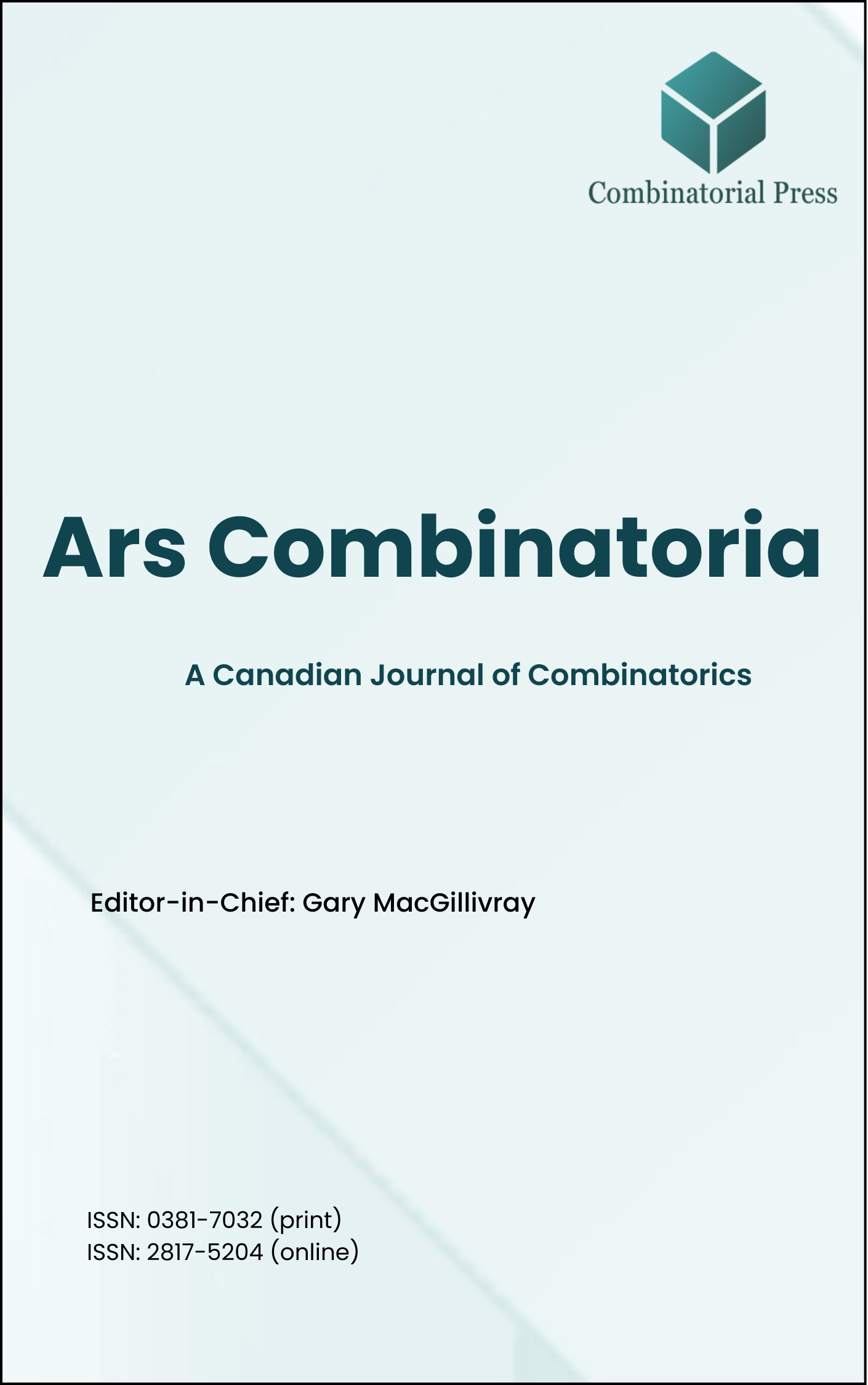
Ars Combinatoria
ISSN 0381-7032 (print), 2817-5204 (online)
Ars Combinatoria is the oldest Canadian Journal of Combinatorics, established in 1976. The journal is dedicated to advancing the field of combinatorial mathematics through the publication of high-quality research papers. From 2024 onward, it publishes four volumes per year in March, June, September and December. Ars Combinatoria has gained recognition and visibility in the academic community and is indexed in renowned databases such as MathSciNet, Zentralblatt, and Scopus. The Scope of the journal includes Graph theory, Design theory, Extremal combinatorics, Enumeration, Algebraic combinatorics, Combinatorial optimization, Ramsey theory, Automorphism groups, Coding theory, Finite geometries, Chemical graph theory but not limited.
Information Menu
- Research article
- https://doi.org/10.61091/ars159-03
- Full Text
- Ars Combinatoria
- Volume 159
- Pages: 21-30
- Published: 30/06/2024
Let
- Research article
- https://doi.org/10.61091/ars159-02
- Full Text
- Ars Combinatoria
- Volume 159
- Pages: 11-20
- Published: 30/06/2024
After the Chartrand definition of graph labeling, since 1988 many graph families have been labeled through mathematical techniques. A basic approach in those labelings was to find a pattern among the labels and then prove them using sequences and series formulae. In 2018, Asim applied computer-based algorithms to overcome this limitation and label such families where mathematical solutions were either not available or the solution was not optimum. Asim et al. in 2018 introduced the algorithmic solution in the area of edge irregular labeling for computing a better upper-bound of the complete graph
- Research article
- https://doi.org/10.61091/ars159-01
- Full Text
- Ars Combinatoria
- Volume 159
- Pages: 03-10
- Published: 30/06/2024
A graph
- Research article
- https://doi.org/10.61091/ars158-12
- Full Text
- Ars Combinatoria
- Volume 158
- Pages: 117-128
- Published: 31/03/2024
In this article, we define
- Research article
- https://doi.org/10.61091/ars158-11
- Full Text
- Ars Combinatoria
- Volume 158
- Pages: 107-115
- Published: 31/03/2024
Stanley considered Dyck paths where each maximal run of down-steps to the
- Research article
- https://doi.org/10.61091/ars158-10
- Full Text
- Ars Combinatoria
- Volume 158
- Pages: 93-106
- Published: 31/03/2024
For
- Research article
- https://doi.org/10.61091/ars158-09
- Full Text
- Ars Combinatoria
- Volume 158
- Pages: 81-92
- Published: 31/03/2024
We consider the following variant of the round-robin scheduling problem:
- Research article
- https://doi.org/10.61091/ars158-08
- Full Text
- Ars Combinatoria
- Volume 158
- Pages: 67-79
- Published: 31/03/2024
Two binary structures
structure
- Research article
- https://doi.org/10.61091/ars158-07
- Full Text
- Ars Combinatoria
- Volume 158
- Pages: 49-66
- Published: 31/03/2024
A tremendous amount of drug experiments revealed that there exists a strong inherent relation between the molecular structures of drugs and their biomedical and pharmacology characteristics. Due to the effectiveness for pharmaceutical and medical scientists of their ability to grasp the biological and chemical characteristics of new drugs, analysis of the bond incident degree (BID) indices is significant of testing the chemical and pharmacological characteristics of drug molecular structures that can make up the defects of chemical and medicine experiments and can provide the theoretical basis for the manufacturing of drugs in pharmaceutical engineering. Such tricks are widely welcomed in developing areas where enough money is lacked to afford sufficient equipment, relevant chemical reagents, and human resources which are required to investigate the performance and the side effects of existing new drugs. This work is devoted to establishing a general expression for calculating the bond incident degree (BID) indices of the line graphs of various well-known chemical structures in drugs, based on the drug molecular structure analysis and edge dividing technique, which is quite common in drug molecular graphs.
- Research article
- https://doi.org/10.61091/ars158-06
- Full Text
- Ars Combinatoria
- Volume 158
- Pages: 41-48
- Published: 31/03/2024
In this paper, we introduce a graph structure, called component intersection graph, on a finite dimensional vector space





